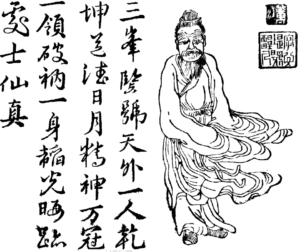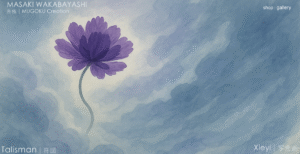The term “Mukonju” (Rootless Tree) does not signify a tree without roots, but rather a being that is able to connect with the very source of all things.
In Daoist teachings, to be rootless means to be free from fixed ideas and material attachments, allowing one to touch the origin of all existence and live freely.
The poems of Mukonju express the harmony with heaven and earth, the cyclical flow of yin and yang, and the “primordial force” that holds infinite possibilities.
Though rootless, it encompasses all powers within, bound by nothing, and symbolizes the strength to live with true freedom.
The teachings of Mukonju are not merely theoretical.
The repeated appearance of the word “rootless” in the poetry signifies the inner strength to seek one’s origin precisely because one has no external roots. It teaches us that to attain true freedom in this world, we must touch that very origin.
The teaching of Mukonju is not a fixed form, but an open guide for everyone, serving as inspiration for each to walk their own path.
Zhang Sanfeng

Zhang Sanfeng, who left behind the “Mukonju” verses, was a legendary Daoist and the founder of the Wudang school in China.
His real name was Zhang Quanyi (or Zhang Junbao), and his courtesy name was Sanfeng. He is believed to have been born in either 1247 or 1264 in Yizhou, Liaodong (present-day Liaoning Province).
He was active during the late Southern Song and early Ming dynasties, known as a Daoist cultivator who trained at Mount Wudang. Due to his ascetic and unadorned lifestyle, he was nicknamed “Zhang Lata,” meaning “Zhang the Sloppy.”
This referred not to carelessness, but to his free-spirited and unaffected nature—a sage-like figure living naturally and detached from worldly concerns.
Zhang Sanfeng mastered the Daoist internal alchemical arts (Neidan), attaining an immortal-like state through rigorous training of mind and body.
He also embraced and harmonized Confucianism, Buddhism, and Daoism, advocating that “the Dao is the common root of all three teachings.” This concept of “Three Teachings in One” profoundly influenced later Daoist development.
As the founder of the Wudang martial arts tradition, he systematized ancient Daoist martial principles and spread his teachings—particularly through Taijiquan—centered at Mount Wudang.
Zhang Sanfeng is believed to have authored many Daoist texts, including the *Xuantan Quanshu* and the *Mukonju Poems*. These works elaborate on internal alchemy, training practices, and his Three-Teachings-integrated philosophy, contributing significantly to Daoist doctrine and cultivation systems.
What is a Rootless Tree?
1. Mukonju and Deep Roots
• The “Rootless Tree” symbolizes complete freedom, unconstrained by material support or external foundations.
• It represents a being of independent spirit, free from the bondage of worldly concerns.
• It is a symbol of the realm of liberation from worldly constraints and the embodiment of a pure spirit.
2. Roots as Inner Depth
• Roots are not merely physical but symbolize inner will and spiritual depth.
• “Deep-rooted” refers to psychological stability unaffected by external conditions and a profound inner anchor.
• Thus, the free realm of the Mukonju is one that possesses deep internal roots and can stand resilient against hardship.
3. Connection with Taijiquan
• In Taijiquan, the concept of “root” is essential, referring to one’s fundamental energy and internal strength.
• Even without external roots, if the body and mind are balanced, one remains unmoved by external force.
• This teaches that true strength lies not in physical support, but in one’s internal essence.
4. Resonance with Zen and Daoist Thought
• Zen and Daoism emphasize concepts such as “emptiness” and “non-attachment.”
• “Rootlessness” is aligned with the free spirit of detachment and the Daoist principle of “wu wei” (non-action, naturalness).
• In this sense, being rootless itself symbolizes spiritual freedom and strength.
Conclusion
This seemingly paradoxical expression carries the message that “true strength lies in deepening one’s inner power without relying on external roots.”
Rather than a literal tree root, it symbolizes spiritual will and inner force, embodying growth in internal martial arts and traditional Eastern philosophy.
The idea of “Mukonju” contains profound paradoxes unique to Eastern thought. The instability of having no visible root gives rise to deep inner strength and freedom.
These verses resonate with the spiritual training of Taijiquan and internal alchemy, valuing not only outward movement but also inner power.
The second poem clearly defines the conceptual foundation for the term “Mukonju” as it appears in the later verses.







